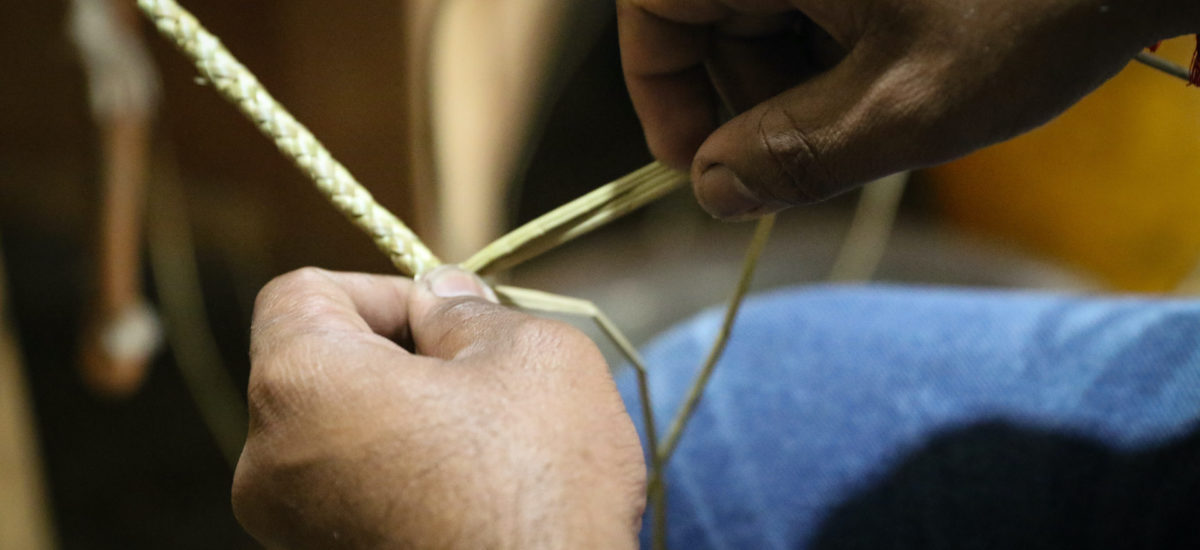A destructive civil war, social upheaval, market forces and plastic have all played a part in the gradual erosion of Jaffna’s rich legacy of arts and crafts. A major dyeing and weaving centre before colonization, its skilled artisans have gradually disappeared, taking with them a wealth of irreplaceable knowledge. At one point, almost ten percent of the northern population was involved in the craft industry.
For a fledging industry that relies on tourists and diaspora clients, the most recent set back was Covid-19 that disrupted the flow of visitors who purchased the products.
But it’s not just about selling because it is a self-sustaining venture based on innovation, creativity, preserving old designs and techniques and helping vulnerable communities.
For the past four years, Sanathanan Thamotharampillai contemporary artist and senior lecturer in Fine Arts at the University of Jaffna and designer Pradeep Thalawatta have been struggling against the odds to establish their brand, Kolam, in the marketplace with a unique range of hand painted and embroidered sarees, copper and palmyra jewellery and woven bags. The products are crafted by hand with emotion, unlike machine manufactured objects, using locally available natural materials and local techniques.
Funded by the Manitha Neyam Trust, Kolam – which means pattern in Tamil – began in February 2017 in collaboration with graduates from the Art and Design Unit of the University of Jaffna, enabling them to become entrepreneurs. Through information gathered from 78 craftsmen, they researched and learnt about traditional materials, techniques and design.
“We started project as a means of archiving of local history because this knowledge was not passing to the other generations. We have combined the skill and knowledge available in the university system with the skill and knowledge of the local artisan community when new opportunities opened up after the war. We revisited the concept of arts and crafts to match contemporary need,” said co-founder Sanathanan Thamotharampillai.
“It is a collaborative process where we research old techniques and meet craftspeople to understand the process of design and preservation. There are various techniques such as when you should cut the shoot of the palmyra to get it ready for weaving. There is a balance between people and nature,” he added.
The colours of the cloth are earthy and muted, coming from dyes made out of cow’s milk, jaggery, neem and mangrove. The palmyra bags are edged with soft colours and embellished with copper and brass, mixing materials and skills of the artisans to create products that belong to no one person but to everyone.
Kolam is situated in a gracious colonial house with a large garden with enough space for barrels of dye, metal cutters, sewing machines, looms and display racks. The 20 artisans can work in a quiet atmosphere with little to disturb them.
It is an ambitious project, where marketing remains one of the main obstacles to overcome in face of cheaper and more durable alternatives. Fortunately, a shop in Colombo is selling the products but sales are slow, especially because the Covid-19 situation.
“Markets are difficult to find. We are trying to reach the middle class, not the elite. But the cost of raw materials and salaries have gone up,” Mr. Thamotharampillai pointed out.
Some objects were household items such as baskets, trays and bags, meant for practical purposes and probably created by the women in the household with love and care either for home use or to be given as gifts. The weaving is intricate, differing from area to area.
The sarees and clothes are woven from Jaffna cotton and coloured with natural dyes produced at the workshop. The methods have been perfected through a process of trial and error.
The products are a combination of different materials – palmyra bags have metal clasps, woven jewellery is edged with copper and dyed sarees are hand painted, mixing and matching different skills and craftspeople, leading to a larger collaboration so that the authorship does not belong to one person but to a community of artistes and artisans.
See video for excerpts from a conversation with Sanathanan Thamotharampillai.





